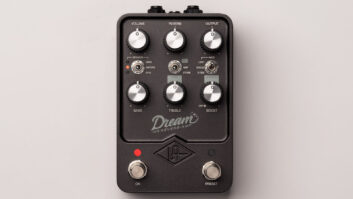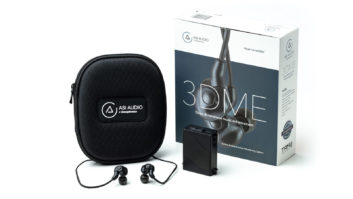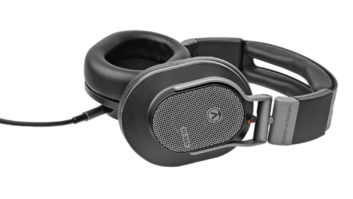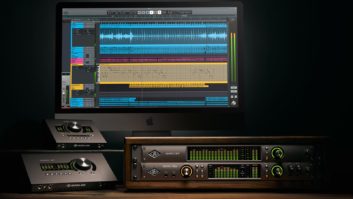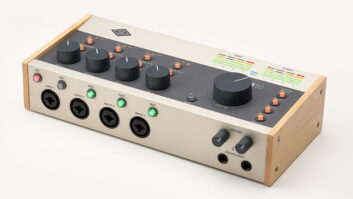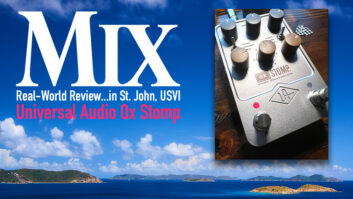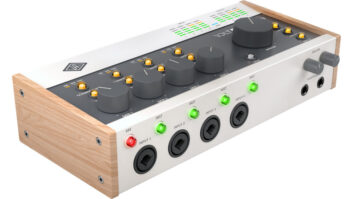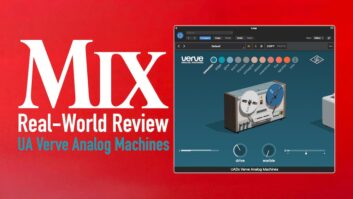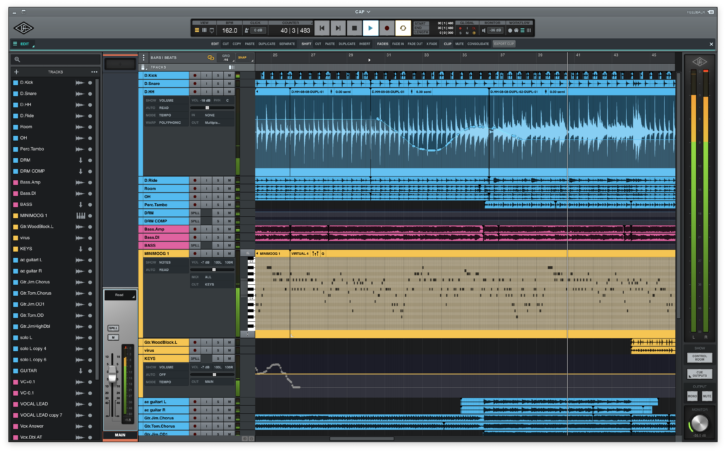
Universal Audio refers to Luna as a “recording system” because of its tight integration with the company’s Apollo and Arrow audio interfaces. Luna uses the DSP from UAD devices for powering UAD effects and for virtually eliminating latency when tracking. Luna is a free application, but you must be a registered owner of a compatible UAD interface.
Luna incorporates the industry-standard analog modeling made famous in UAD plug-ins to create a recording environment where you can apply built-in tape emulation on every track. Some of the optional Extensions available for purchase, including Neve Summing, can enhance the analog vibe even more.
Currently, Luna is for Mac only. I tested it on a “Garbage Can” Mac Pro running a UAD setup that includes a first-generation Apollo Twin Duo and a UAD 2 Quad Satellite.
The Luna Landscape
One of the advantages in creating a new DAW is that the developer isn’t bogged down with legacy features. They begin with a proverbial “clean slate,” and can employ the latest technology—and the experience gleaned from using and evaluating other DAWs—to inform their design.
Indeed, some of the features in Luna’s GUI will seem familiar. Its structure of two main windows, the Timeline view and the Mixer view, is reminiscent of Pro Tools, and a number of its essential key commands are the same. Selecting multiple tracks in the Mixer creates a temporary track group, just like in Logic Pro X. The way you can open and close horizontal sections of the Mixer (Sends, Inserts, etc.) reminds me of the Cubase/Nuendo console.
The point isn’t that Luna is derivative. UA was smart to see what works and what doesn’t in other DAWs and adopt some of the better existing ideas to supplement their innovative ones, of which there are quite a few. UA clearly made an effort to address some of the shortcomings they’ve observed in other workstations.
One of those innovations is called the Focus Browser. It’s a sizable vertical strip at the extreme left of both main screens. Contextual in nature, it shows different lists of choices appropriate to what you’re working on. For example, if you press a Send slot in the Mixer view, a list of available sends will automatically show up in the Focus Browser.
Or let’s say you’re using a virtual instrument or processing plug-in. Clicking the Preset window in the instrument’s GUI brings up a list of all the available Presets in the Focus Browser. It’s a smart feature that helps make Luna super-efficient.
Another innovation is called Workflows. It lets you change the contents of the Toolbar buttons at the top of both the Timeline and Mixer windows to match what you’re doing at any given time. It provides four choices—Record, Edit, Mix and MIDI—which you can switch between by pressing buttons or selecting from a dropdown menu.
Importing and Conversions
You can import any WAV, AIFF, AAC or MP3 file, no matter the sampling rate. Luna will convert the data on the fly to conform to your session. You never have to worry about those “Your audio is at the wrong sample rate” error messages that are so common in other DAWs. Luna also automatically time stretches any file with embedded tempo information to match your setting.
Whenever you import an audio file into Luna, it automatically puts it on a new track in the Timeline. There’s no global audio window (à la Pro Tools’ Clip List) where you can manage all of your session files and choose which ones to bring into the Timeline. As a result, your Timeline can get pretty cluttered if you, say, import a collection of drum loops you’re planning on using to create a song-length part.
I was a bit surprised—but extremely pleased—to find that Luna supports AU plug-ins. I didn’t expect that for a couple of reasons: First, UA has its own robust plug-in collection, for which an “all UAD” Luna could help spur additional sales. Second, third-party plug-ins are a significant cause of instability in DAWs. Keeping it all “in-house” would have made things easier in the coding department.
But, as someone who has a significant investment in plug-ins, including some that are key to my own workflow, the AU support made Luna much more accessible and practical.
Recording
The hardware/software integration of the Luna system manifests itself most spectacularly when you’re recording, thanks to a feature UA calls Accelerated Realtime Monitoring (ARM). It uses the DSP in your UAD system (if you have more than one UAD device, it will pull from both) to create input monitoring without any noticeable latency. When tracking guitars, bass and vocals, I experienced no delay with ARM activated.
With ARM on, I was also able to successfully record new audio in a session that was well into its mixing phase, and contained many tracks and lots of plug-ins. In other DAWs, this would cause the new track to be out of sync. I would have had to freeze a bunch of tracks or even do my overdub to a reference mix in a new session and import it back into the original to avoid timing issues.
ARM turns on and off globally. If you have a lot of UAD plug-ins while recording (the more tracks in record, the more DSP needed), Luna will sometimes switch off certain ones to borrow their DSP. But as soon as you turn ARM off, everything reverts to normal.
Luna allows you to create up to four separate Cue mixes, depending on the interface you own and its output configuration. (I had the option for two on the Apollo Twin.) You can even assign two aux busses to ARM for monitoring reverb and delay without latency. Configuring the Cue mixes is not as intuitive as some of the other features in Luna.
Luna’s Mixer handles the same functionality as the UAD Console app for those recording through UAD interfaces into other DAWs. One of those functions is hosting Unison-Enabled preamp plug-ins that you can insert in your recording chain to change the character of your Apollo or Arrow preamps.
Editing Audio
You can adjust both Clip Gain and Pitch in the Timeline directly from any audio region, referred to in Luna as a Clip. You can make these adjustments from the Clip itself or bring up a dialog box with those parameters on knobs, along with some other adjustable parameters.
For waveform editing, you don’t get an array of tools, as is the custom in many DAWs. Instead, the cursor becomes the Editing Tool, which is contextual and changes function depending on where you place it in a Clip. You can use it to select edit points or ranges within a Clip, add fades in and out, and add crossfades between two Clips. To cut, you place the cursor on one spot or drag to create a range, then use the Command + E shortcut.
Luna’s audio-warping features are robust and include five different user-selectable algorithms. Select an audio clip and choose Warp from the Focus Browser, and you’ll see all the transients displayed as draggable Warp Markers.
MIDI
The MIDI recording and editing features are straightforward. You edit directly in the Timeline’s MIDI tracks using one of two modes: Clips or Notes.
Notes mode turns your MIDI track into a piano roll-style editor with a contextual multi-tool. You can open a Velocity editing lane at the bottom of each track, and right-clicking on a note brings up additional editing functions, including Quantize.
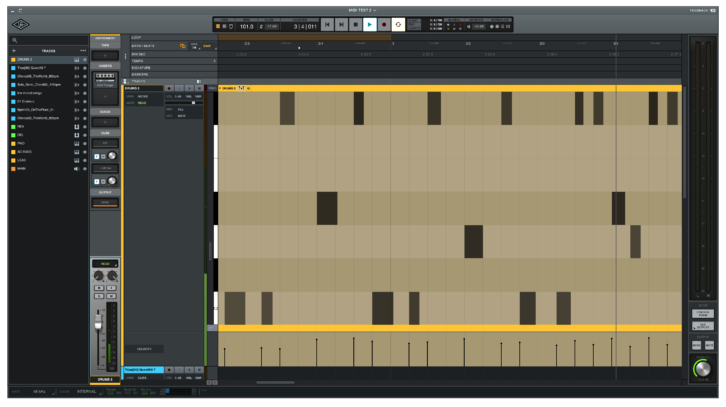
Clips mode allows you to edit MIDI regions. For example, if you’ve put together an eight-measure beat, you can easily copy and paste it throughout the song.
Clicking in the View field in the track header brings up a Focus Browser showing available automation parameters, including available controllers for the MIDI instrument assigned the track.
One of Luna’s included Extensions is the ARP MIDI Arpeggiator. Featuring a range of patterns and octaves, it’s an excellent tool for sparking creative ideas, and lots of fun to experiment with.
Overall, Luna’s MIDI implementation doesn’t offer the depth available in programs like Logic Pro X, Digital Performer and Cubase, nor does it include notation editing. But its MIDI toolset is solid and is more than adequate for recording and editing virtual instruments.
Instruments
Luna’s virtual instruments are quite impressive. Only one, the multipurpose virtual instrument called Shape, is included. The other two are available for purchase. Shape has a broad range of excellent-sounding instruments, including drums, basses, synths, horns and even strings with various articulations. You can also open four simultaneous instruments in each instance of Shape, which makes layering sounds easy.
Shape also includes Ravel LT, adapted from the full version of Ravel, one of the optional instruments. I compared Ravel LT to Ravel, and sonically, the differences were surprisingly small.
Another optional instrument is Moog Minimoog, a spectacular emulation that UA developed in conjunction with Moog. It may be the best-sounding software Minimoog I’ve ever played.
Luna currently offers several Spitfire Audio orchestral instrument packs as Extensions and several bundles of Extension products, all of which you can purchase from within the application.
Mixing
The Mixer in Luna is configurable and easy to use. You can show or hide the various sections above the fader area by clicking disclosure arrows. The default pan control for a stereo track features separate left and right knobs. However, if you’d prefer a single knob for stereo, just control-click on the pan control and it switches. Configuring buses and sends is fast and easy, thanks in large part to the Focus Browser, which displays choices automatically, depending on what you’re setting up.
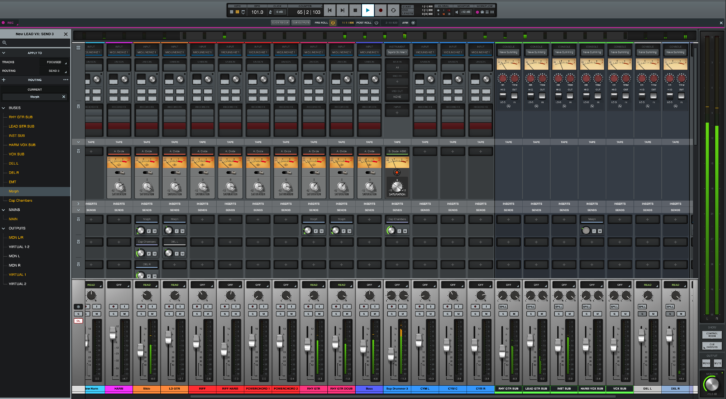
Automation is well-implemented. You can access parameters to automate from the Focus Browser. You can write or change automation in real time or by drawing-in and editing breakpoint lines in the tracks.
My only complaint about the automation is that you don’t see a readout of its current value when you click-on or click-and-move a breakpoint. I found this problematic when dealing with volume levels, in particular. In some situations, the only way to tell if a line is entirely straight is visual, which isn’t all that accurate.
Bus Spill is a useful mixer feature I haven’t encountered in any other DAW. Every bus track you create has a Spill button, and when you click it, you see only the bus channel, the master (aka Main) channel and all the channels assigned to the selected bus. It’s great for making sure that you’ve assigned every track you intended to a particular bus, or just to hide the rest of the tracks so you can focus on one section.
Mixer Modifiers is another handy time-saving feature that allows you to quickly change settings to multiple items in the Mixer rows that reside above the Fader section. By clicking or swiping, you can copy and paste output assignments and sends, power off plug-ins and cue sends, and more.
Luna’s mixdown features are powerful. In addition to doing full stereo mixes (real time or offline), you can tell Luna to render individual tracks and buses.
The Tape slot in the Mixer lets you add the sound of analog tape to each track individually. UA’s Oxide Tape emulation is included with Luna and sounds excellent. UAD offers its Studer A800 tape emulation as an optional Extension. If you already own the plug-in version, Luna will automatically make the Studer A800 available for the Tape slot.
The optional Neve Summing Extension emulates the summing characteristics of a Neve console. Controls include Trim (input level), HR (headroom) and Hi Ω or Lo Ω (impedance). With Neve Summing installed on your Main (master) track and buses, you get subtle saturation and presence that’s quite pleasing.
Impressions
I used Luna for several recording and mixing projects, and my overall impression is extremely positive. For a version 1 application, I found it quite stable. Crashing during sessions was rarely an issue, which is more than I can say for some DAWs that have been on the market for years. Luna also includes an autosave feature that protects you if you do lose data.
The Luna user interface is exceptionally intuitive and provides a well-designed overall approach that includes some useful new features and concepts. Luna’s AU plug-in support is also noteworthy; being able to open familiar processors and instruments makes the transition from other DAWs much easier.
As you would expect from a Universal Audio product, Luna sounds excellent, even if you don’t have the Neve Summing and the Studer A800 tape emulation. Perhaps Luna’s most impressive feature is the ability to record with no latency using ARM.
The outstanding quality of its MIDI instruments is another huge plus for Luna. I hope UAD puts out more because the first three are killer. Even Shape has many superb sounds and goes well beyond what most included, multipurpose instruments offer.
Sure, there are some features it would be nice to see added. Video import and render is one, so you could use Luna when writing music for picture. Value readouts when adjusting automation would be another. A better way to manage imported files would be a big help, too. To that point, UA says it’s planning more comprehensive media management features for a future release.
But overall, Luna is super-impressive. It may not yet have the depth of features of some of its competitors, but for music production, it’s already a force to be reckoned with. If you already own an Apollo or Arrow, do yourself a favor and check it out. I’m confident you’ll be intrigued.
Product Summary
COMPANY: Universal Audio
PRODUCT: Luna
WEBSITE: www.uaudio.com
PRICE: Free for owners of Thunderbolt Apollo and Arrow interfaces (Mac only)
PROS: ARM feature allows for no-latency monitoring; excellent, analog-like sound; tape emulation can be added to every track and bus; Neve Summing option adds console emulation; Shape virtual instrument versatile and excellent-sounding; innovative features like Focus Browsers, Workflow and Mix Modifiers; support for up to four cue mixes (interface dependent); supports AU processors and instruments; on-the-fly conversion for imported files
CONS: No dedicated order for audio track management; no level readouts when editing automation; no Windows support; no video support
